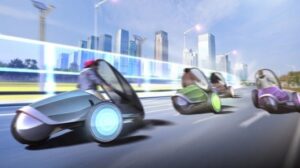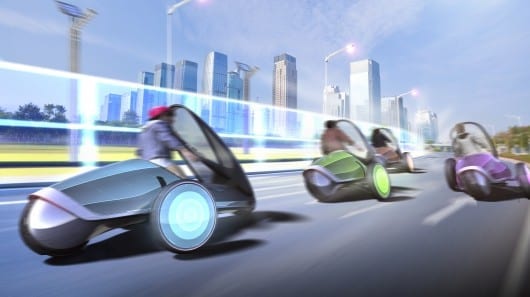
One of the many themes of the FV2 is the expression of Toyota’s “Fun to Drive” philosophy
Toyota’s already bold pursuit of new vistas in the realm of personal transportation took another quantum leap forward today, when the Japanese giant released details of the FV2, a concept car more closely related to the Kirobo humanoid communication robot than any vehicle currently on public roads.
In trying to explain the FV2 succinctly, it’s probably best to start with how it isn’t different from a contemporary car. It has four wheels. That’s about it, and what’s more, it rearranges those four wheels in a diamond shape and it tilts in corners, a bit like a motorcycle with giant training wheels on each side.
The FV2 can be driven from a seated position with the canopy closed, or from a standing position with the canopy open, with the transparent canopy becoming a full-height windshield with an extensive augmented reality display.
In both cases, the vehicle is steered, accelerated and braked by body movement.
It’s not the first Toyota to use an external high-resolution display on its exterior, with the FUN Vii doing the show rounds for the last two years after being shown at the Tokyo Motor Show in 2011. Toyota’s experiments with expressing the driver’s emotions on a vehicle’s exterior date back more than a decade to the Personal Mobility Concept of 2003 and the POD concept of 2001, and the company patented this feature in 2002.
One of the many themes of the FV2 is the expression of Toyota’s “Fun to Drive” philosophy, and the computer-human interface we first experienced with the Segway and its natural weight-shift steering has been incorporated into the FV2 to create a greater physical bonding between car and driver.
As cars and robots converge, advanced technologies will also be used to enhance the driving experience by connecting emotionally with the driver, and the FV2 is the first vehicle to incorporate some of the lessons learned in the Toyota Heart Project, a new communication research study featuring the well-known Kirobo and Mirata humanoid communication robots.
Robots are being developed for many uses, and Japanese robotics research is well advanced in the area of companion robots using artificial intelligence plus voice analysis, image recognition of facial expressions, body movement and hand gestures to respond in such a way as to create an emotional connection between humans and robots.
Go deeper with Bing News on:
Companion robot
- Fact Check: The Truth About Alleged Elon Musk Post on a Future Robotic 'Housewife Who Never Nags'
A screenshot from April 2024 shows a real Elon Musk tweet claiming that, within 20 years, robots would exist that were sexually compatible with humans and that would act like a "housewife who never ...
- Ohio company to sell a ‘flamethrower-wielding robot dog’ called the Thermonator
Touted as “your ultimate firepower companion”, the robot’s uses include wildlife control and prevention, agricultural management, ecological conservation, and snow and ice removal ...
- Say Goodbye to Backseat Meltdowns: Nissan's Iruyo Robot Soothes Babies on the Go
Nissan and Akachan Honpo have developed Iruyo, an intelligent puppet that detects sleep patterns in children's eyes, assisting parents in driving.
- Are robots the solution to the crisis in older-person care?
He became attached to it and when he later fell ill and died, the nursing-home staff found him clutching his robot companion. When the class was asked to offer impressions of the scenario they ...
- How Home Robots Will Change The Technology Industry
We’ve already seen proof that people are willing to adopt home robots with Roomba, and we’re only going to see this market grow in the coming years.
Go deeper with Google Headlines on:
Companion robot
[google_news title=”” keyword=”companion robot” num_posts=”5″ blurb_length=”0″ show_thumb=”left”]
Go deeper with Bing News on:
FV2
- Feed has no items.
Go deeper with Google Headlines on:
FV2
[google_news title=”” keyword=”FV2″ num_posts=”5″ blurb_length=”0″ show_thumb=”left”]










